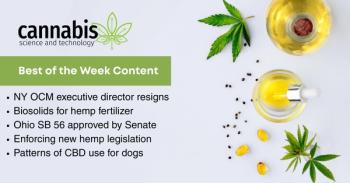
Testing for Pesticides and Mycotoxins in Cannabis: How to Meet Regulatory Requirements

As more states legalize cannabis, increasingly stringent testing requirements are being developed on the state level for pesticide and mycotoxin levels in cannabis products. Cannabis is a very complex matrix, which makes testing to the specified levels a challenge for many laboratories. Avinash Dalmia, a principal R&D Scientist with PerkinElmer, has been working to solve this problem using a liquid chromatography–tandem mass spectrometry (LC–MS/MS) method with electrospray ionization (ESI) and atmospheric pressure chemical ionization (APCI). Here, Dalmia discusses that research and previews an upcoming paper on the topic for our September issue.
In an upcoming article for Cannabis Science and Technology (1), you present a liquid chromatography–tandem mass spectrometry (LC–MS/MS) method with electrospray ionization (ESI) and atmospheric pressure chemical ionization (APCI) to meet cannabis pesticide and mycotoxin residues regulatory requirements in California. How did you get started with that research?
When I started working on cannabis analysis, Oregon cannabis testing labs were struggling with their pesticide methods because of matrix interference. My goal was to address this challenge by developing a fast, sensitive, and validated LC–MS/MS method. I selected to leverage both the ESI and APCI ionization techniques, and optimum multiple reaction monitoring (MRM) transitions, that would allow low level analysis of all of pesticides and mycotoxins regulated by both California and Oregon. An extensive examination of peer-reviewed research literature suggested that some of the nonpolar and chlorinated pesticides, such as chlordane and pentachloronitrobenzene on the California list, cannot be analyzed with LC–MS/MS. As a scientist, I like to work on things that have never been done before and welcomed the challenge. After validation testing of this method with multiple cannabis testing labs and PerkinElmer scientists, I am excited to demonstrate that we can analyze these hydrophobic and chlorinated pesticides at low levels in cannabis with LC–MS/MS. Secondly, it is important to prevent public health risks from consumption of cannabis products tainted with high levels of pesticides. Therefore, by developing an analytical method for pesticides and mycotoxins analysis in cannabis, we can help ensure that cannabis products can meet current state safety regulations, making cannabis safe to consume for both medical and recreation purposes.
What specific challenges do you face when analyzing cannabis pesticide and mycotoxin residues compared to other samples?
Pesticide analysis in cannabis is extremely challenging since the matrix composition is very complex and contains compounds at various concentration levels from different classes such as cannabinoids, terpenes, hydrocarbons, sugars, fatty acids, flavonoids, and others. The complex cannabis matrix leads to ion suppression and matrix interference, and therefore cannabis extracts need to be diluted by an overall factor of 10 in acetonitrile to reduce matrix effects. This dilution means that if you want to detect a pesticide at a level of 100 ppb or lower in cannabis, your method would need to measure pesticides at a level of 10 ppb or lower in the cannabis extract because of the overall dilution factor of 10 during extraction. Also, conventional MRM transitions, used for analysis of some of pesticides in other relatively cleaner matrices, could not be deployed for pesticide analysis in cannabis because of matrix interference. Therefore, to ensure the highest sensitivity, MRM transitions for a number of pesticides with minimal matrix interference in the cannabis matrix were determined for low level detection. For example, acequinocyl is an insecticide and can be ionized easily as a protonated molecular ion in a standard matrix, but the MRM transitions, based on protonated molecular ion in the cannabis matrix, showed poor limits of quantitation (LOQ) of 0.5–1 ppm, about 5–10 times higher than its action limit for the state of California. Therefore, MRM transitions based on alternative modes of ionization, such as adduct formation, were determined to reduce matrix interference and achieve an LOQ of 25 ppb (four times below California action limits) for acequinocyl in the cannabis matrix.
Because of the cannabis matrix’s hydrophobicity, further dilution of the extract cannot be performed with the aqueous mobile phase to make it compatible with reversed-phase columns. This dilution protocol, compatible with other matrices, resulted in lower recoveries of some pesticides in the nonpolar cannabis matrix. However, the reversed-phase LC method uses aqueous mobile phase at the beginning of the LC run to help better retain the polar compounds on the column. Injecting an organic solvent such as an acetonitrile extract of cannabis on the LC leads to poor chromatographic peaks for early eluted polar compounds in reversed-phase LC. To overcome this problem, a small sample injection volume (microliters) of cannabis extract in optimum organic solvent with a reversed-phase LC column was used in our work. Typically, the dirty matrix in cannabis samples would quickly foul the conventional gas chromatography–tandem mass spectrometry (GC–MS/MS) and LC–MS/MS systems, which would increase the maintenance costs and downtime and result in a loss of productivity. I worked with my company’s engineering and product development team to help design and evaluate a new ionization source to reduce the need for maintenance and enable more uptime for the analysis of pesticides in dirty cannabis matrices.
What are the advantages of the LC–MS/MS method compared with other previously used methods for the analysis of pesticides and mycotoxins in cannabis?
LC–MS/MS has emerged as the method of choice for pesticide and mycotoxin analysis because it offers superior selectivity, sensitivity, ruggedness, and does not require extensive sample preparation and derivatization before analysis. LC–MS/MS methods can be utilized for analysis of all of pesticides and mycotoxin residues with different polarities and molecular weights. Other methods are only applicable to a smaller number of pesticides and mycotoxins. Compounds such as daminozide, a highly polar compound, and abamectin, a high-molecular-weight compound, are not amenable to analysis by GC–MS/MS because they are heat labile and degrade in either the GC injection port or the column at high temperature. GC–MS/MS methods are not as robust as LC–MS/MS methods for pesticide analysis in complex matrices since they require extensive sample preparation to prevent GC injection port contamination from complex matrices.
How do the regulations in California differ from other states? Have you developed specific methods for each state that has cannabis pesticide and mycotoxin residues regulatory requirements?
Great question, and the answer is yes. PerkinElmer has developed specific methods for varying state requirements so testing labs are confident about meeting their own state’s regulations. Oregon was one of the first states in the U.S. to issue comprehensive guidelines for pesticide residues analysis in cannabis, and set regulatory limits for 59 pesticides. California issued more stringent action limits (about a factor of 2 to 20 lower than Oregon state action limits) for 66 pesticides (including all but one of those found on Oregon state list, and eight more) and five mycotoxin residues in cannabis flower and edibles. We have developed LC–MS/MS methods that meet both Oregon and California state pesticide and mycotoxin regulatory requirements. I continue to work on forthcoming regulation limits, such as the Health Canada pesticide requirements, which are even lower than California’s.
What do you think readers will learn from your article in Cannabis Science and Technology (1)?
Here are the key results that address a number of the challenges with this this method:
- How to develop an LC–MS/MS method for low-level analysis of pesticides in a complex cannabis matrix with high selectivity using MRM transitions with minimal matrix interference
- Optimization of the source temperature is very important for low level analysis of some of thermally labile pesticides.
- The new method demonstrates that a novel LC–MS/MS method with ESI and APCI can be used for the analysis of all of mycotoxin and pesticide residues, including very hydrophobic and chlorinated ones, in complex cannabis matrices.
- The simple solvent extraction method has several advantages compared to QuEChERS (quick, easy, cheap, effective, rugged, and safe) for efficient extraction of all of pesticide and mycotoxin residues in cannabis matrix.
What are the next steps in your cannabis research?
This summer the government in Canada passed a federal law to allow its residents to use cannabis for medical and recreation purposes. Canada has issued more stringent regulatory limits for a bigger panel of pesticide residues in cannabis flower, oil, and fresh plants. To support our Canadian cannabis clients our application team is developing a new LC–MS/MS method to address very low regulatory limits set by Health Canada for pesticide residue analysis in cannabis flowers. Next, we will validate our LC–MS/MS method on a variety of cannabis-related matrices such as cannabis concentrates, edibles, and hemp.
References:
- A. Dalmia, E. Cudjoe, T. Astill, J. Jalali, F. Qin, M. Murphy, and T. Ruthenberg, Cannabis Science and Technology1(3), accepted (2018).
Newsletter
Unlock the latest breakthroughs in cannabis science—subscribe now to get expert insights, research, and industry updates delivered to your inbox.





